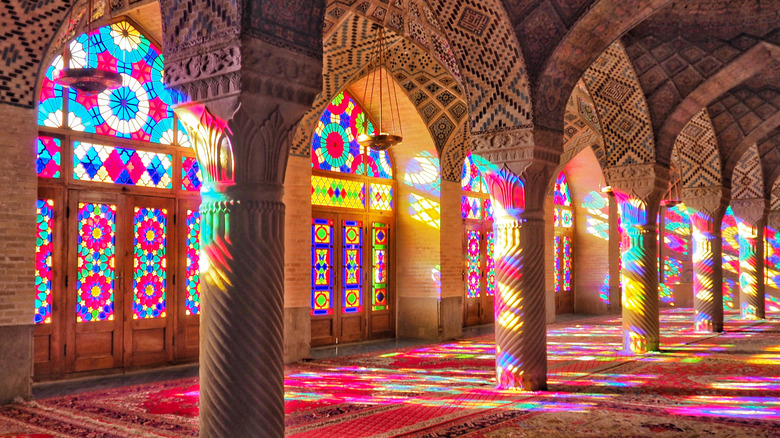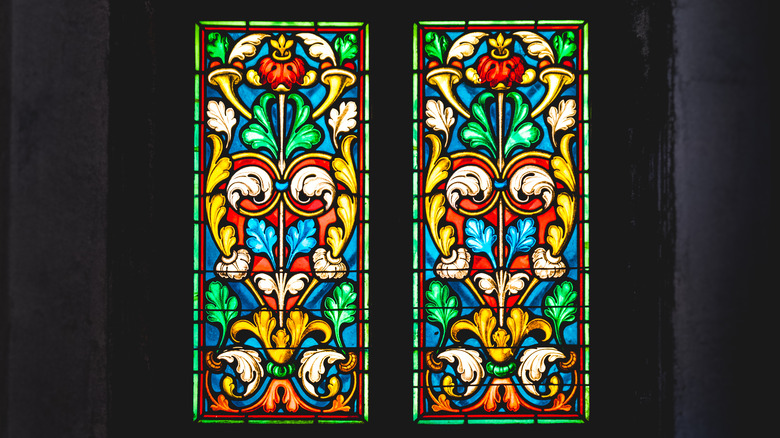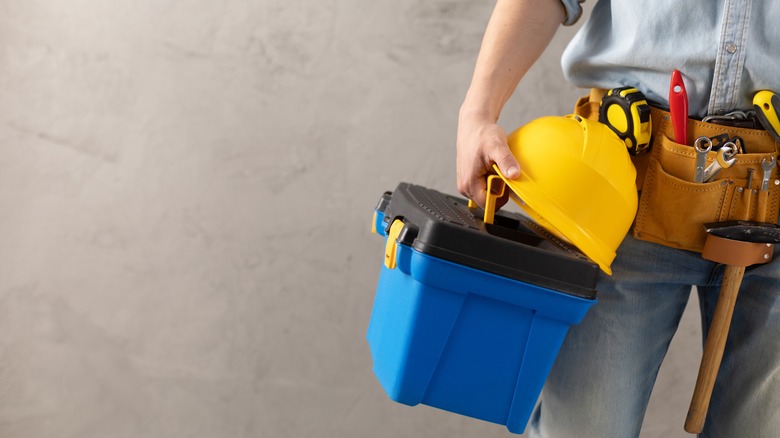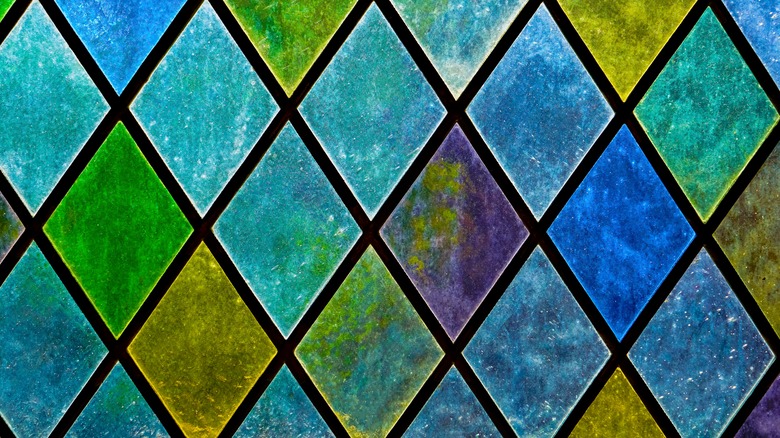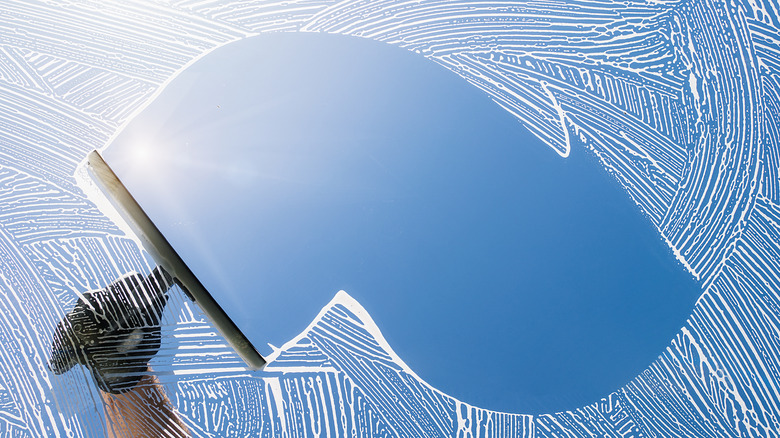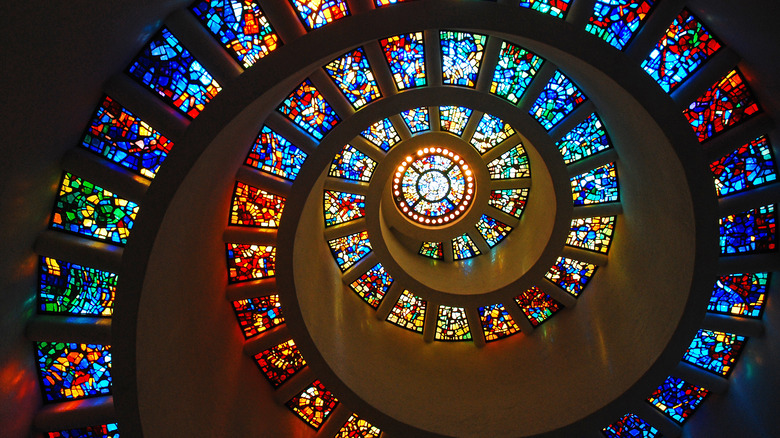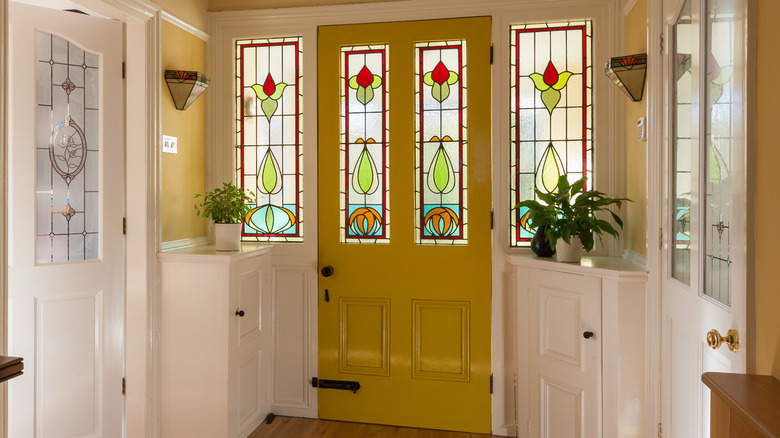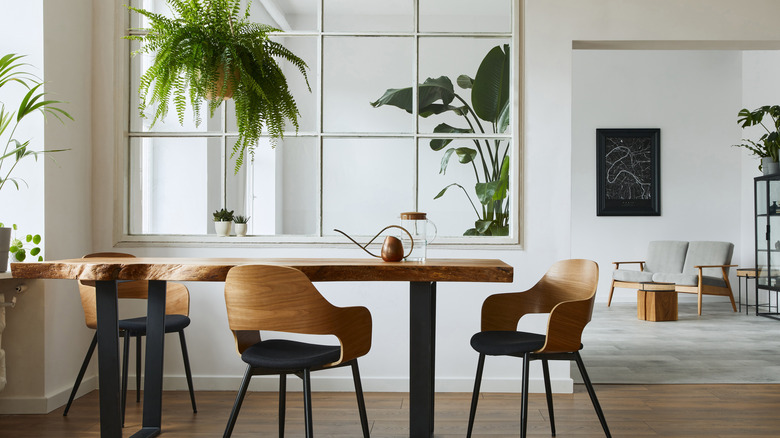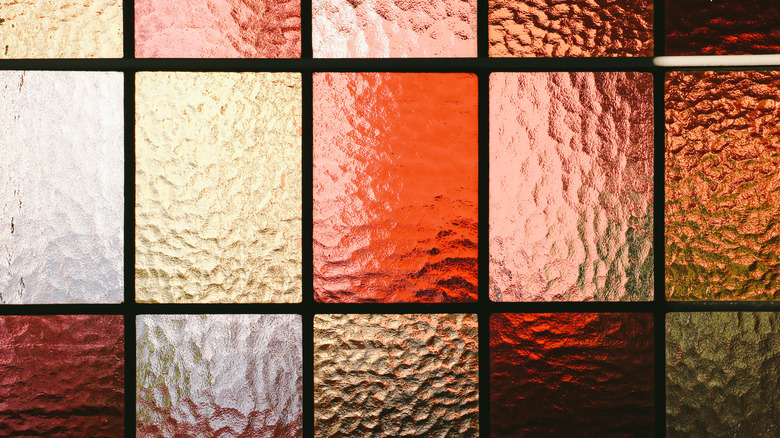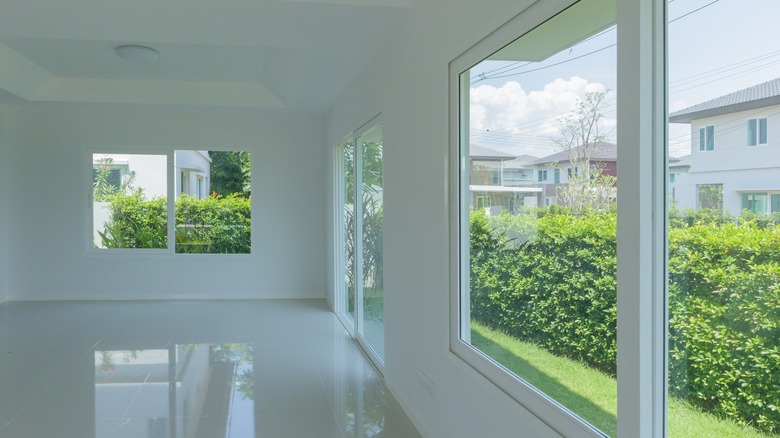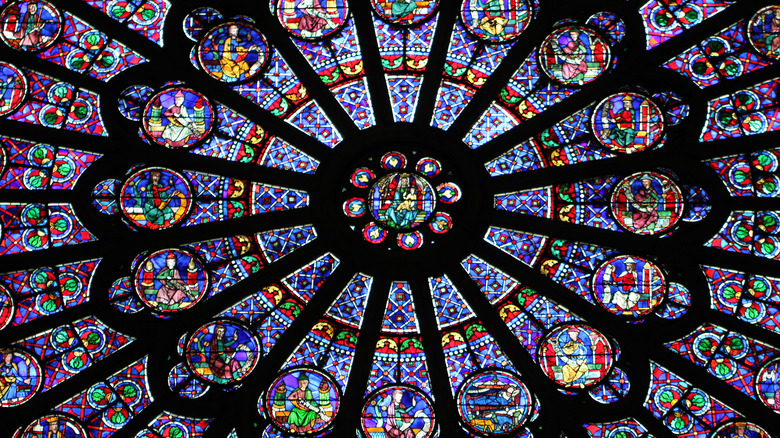What You Need To Know About Adding Stained Glass To Your Home
Stained glass is surely a sight to behold, and when you think of it, you may think of grand and historical churches. However, there's plenty of room to add stained glass to your home. This allows you to revel in its beauty on the day-to-day, adding a sense of color and flair to your home at the same time.
If you're considering adding a stained glass window or display to your home, you may be wondering how this pretty variation of glass even came to be. The Guardian took a deep dive into the science and history of it, sharing that the concept was actually discovered by mistake. Discovered in ancient times, the act of adding different minerals to the molten glass and allowing the melting process to continue for varying amounts of time creates these fabulous colors. For instance, copper-bearing minerals are responsible for red, blue, pink, and purple glass. Iron can yield green or bright yellow glass. Furthermore, the term "stained glass" itself is meant to encompass three different processes that lead to the final result: coloring, staining, and painting.
Now that you have a brief history of how stained glass came to be, let's delve into everything you need to know before you add this beautiful accent to your own space!
It could increase the value of your home
The first thing worth knowing about adding stained glass to your home is that it could actually increase its value. As a homeowner, this is also a welcome addition! Scottish Stained Glass shares more about this and why a stained glass installation can make your house go for more should you put it on the market. The stained glass company explains that in their locale – Houston – adding a $300 stained glass window to your home has shown to increase the market value by up to $3,000. Wow! That's a huge return on your investment. The site goes on to explain that many stained glass windows appraise for upwards of $100 per square foot.
Furthermore, Scottish Stained Glass notes that this colorful addition to your home will increase its curb appeal. Due to the ability to see the bright colors and artful aesthetic from the outside, the attractiveness of your home will increase. Catch the eye of potential buyers with a lovely stained glass entryway window or door.
It's built to last
Although glass is quite breakable by nature, stained glass is built to last. That makes it a smart addition to your home – not only for its obvious aesthetic purposes but also because you know it will stand the test of time. When you think about it, this makes sense since some of the world's oldest churches are adorned with their original stained glass windows, having beautifully lasted for hundreds of years.
Stanton Studios sheds light on how strong stained glass really is. Stained glass windows undergo a process called grouting, which means that they're waterproofed. In this process, grouting is spread all over the stained glass window. Once it dries, it is taken off and the glass is buffed. This is time-consuming because, by nature, stained glass is not perfectly smooth. It's a painstaking process to get all of the grout off of the uneven glass, but the work is well worth it.
This entire process is important to making a window watertight, which allows it to stand up to the outside elements it will face throughout its lifetime.
You can do a DIY installation
While adding a stained glass window to your home may seem like a complicated procedure, DIY lovers will be glad to know that you can, in fact, do it yourself! J. Harmon Design provides a look at what it takes to add a stained glass window to your home independently. In the video, an antique stained glass window is added to an interior wall. A seamless installation requires careful measuring, although this video exemplifies the fact that you can add the window to the space even if it's not an exact fit. If that's the case, you can use a material like plywood to create a platform for the window to rest on along each side. From there, caulking and painting along the edges will create a seamless look for the window, and it'll look like it was always a part of your home!
It provides heightened privacy
Another benefit of having a stained glass window or door is that it can enhance privacy within your home. Cumberland Stained Glass discusses this upside. The site notes that a stained glass window could be perfect for a bathroom window, since it provides an added shield of privacy along with a beautiful aesthetic. Additionally, if you have a front door that's flanked by windows, stained glass paneling does a great job allowing light to enter while ensuring that people can't look right into your home. The addition of stained glass will also add that highly desired curb appeal to the front of your home.
Finally, stained glass is easier to maintain than blinds. Although blinds are another effective method of enhancing your privacy, they're known to get dusty and to be cumbersome to clean. On the other hand, stained glass windows can be wiped relatively quickly and easily for a quick refresh!
Stained glass requires special care
It's important to understand the care that stained glass will require before you add it to your home. Although it's relatively easy to care for, it has different demands than a regular window or door. Martha Stewart provides some insight into how you can best maintain stained glass features in your home. "The surface of the stained glass is not as smooth as regular window glass and can trap dirt more easily," explains Steve Blyth, president of the window cleaning firm J.Racenstein Company.
To best clean your stained glass, the site explains that you should use a nontoxic cleaner that's free of alcohol or ammonia. Using cleaners with those chemicals could damage the solder that holds the window together. Dish soap should never be used to clean the glass, as it could cause discoloration. Instead, a foam cleaning spray is the best option for stained glass. After you're done with the cleaning solution, you should use a microfiber cloth to gently dry the glass. Even just wiping the glass down with a dry microfiber towel in between deep cleans can remove dust, dirt, and other unwanted residues.
It can add style and color to your home
Adding a stained glass feature to your home will really elevate its style and will, of course, add a pop of color to your space. Home Edit talks about how stained glass is super versatile and can add a sense of style to any space, regardless of what vibe you're going for. The article emphasizes just how many ways there are to add a stained glass feature to your home. While many people think of a standard stained glass door or window, there are alternate options that allow you to choose the option that's best suited to your style and preferences. For instance, an arched window, interior french doors, or a stained glass skylight could be just what you're looking for to make your interior your own. Other options include a stained glass light fixture or custom stained glass cabinets. Options abound!
There are different styles to choose from
To go along with the different methods of adding stained glass to your home, there are also seemingly endless designs that make up these features, allowing you to further customize the look and feel of this accent piece. Artistry In Glass shares more about the wealth of designs available when it comes to stained glass and how to choose one for you. The first thing to keep in mind is that the more complex the glass design is, the more expensive the piece will be.
When it comes to communicating or choosing the design you want, you will have to first think about if you have a particular element you'll want to be included in the design. For instance, if you live in a coastal area, maybe you want a palm tree incorporated into the design. If not, you'll want to have a particular style in mind. For example, maybe you're going for a design with country charm or, alternatively, a geometric style. Finally, have a color scheme in mind to help narrow down your exact design.
The price of stained glass ranges
Another important factor to understand regarding a stained glass in-home installation is that the price of different pieces ranges. Custom Stained Glass Houston provides a useful guide to give an idea of what factors will affect the price of your stained glass feature.
The guide explains that the base price will be based on the size of your window. As expected, the larger the window or door, the more you can expect to pay. Next, the number of pieces in the stained glass design along with the complexity of each piece will contribute to the cost. These usually fall into one of three categories. The first is a simple design, which is typically a more geometric style that has twenty items or fewer. Next is a complex design that features an intricate pattern, including anywhere between 20 to 100 pieces. Finally, the last category is a custom design, which includes many pieces and specialty items such as beveled glass, painted glass, or a sandblasted or etched design. These items are typically charged per square foot.
It's good for modern homes, too
As previously mentioned, stained glass is not just good for traditional or contemporary style homes! It's also a great fit for homes that have a more modern vibe associated with them. Modernize depicts this and shares which types of stained glass windows are best suited for homes that fall into this style bucket. For instance, a mosaic-style window encompassing different colors is a great option for a modern home. Or, consider a stained glass installation inspired by Frank Lloyd Wright. This famous architect was the first to fuse stained glass with the idea of a modern home. A piece with geometric patterns and neutral hues could be the perfect fit to complement your sleek and modern space! Finally, a large-scale installation in your living space could really make a statement. Use modern geometric shapes and a cohesive color scheme to play up the look.
Stained glass doesn't fade in the sun
Something that a lot of people wonder about stained glass is whether its bright and eye-catching color will fade in the sun. This is a worry for people investing in these pieces for their home, as they want to rest assured that their beautiful window, door, or accent will look exactly as they envisioned it for a long time to come. Fort Collins Stained Glass answers that question, denoting that the colors of stained glass will not, in fact, fade over time. This is because when stained glass is made, it's heated to such a high temperature so that the silica molecules incorporate the other minerals into its structure. The color is dictated by which mineral is used. Then, once the glass has cooled, the new molecular structures are locked in. The only thing that can alter them from there is that high level of heat. That means that the creation will last 100 years or more before requiring serious repair.
You may need to use a covering or glazing system to protect your stained glass
While stained glass is certainly built to last, you may need to use some protection for yours in order to keep it in tip-top shape for the long haul. Willet Hauser discusses this and explains the need further, noting that severe weather events such as hurricanes, blizzards, tornadoes, hail, or heavy winds could demand the need for a protective layer over your stained glass feature. This will prevent wear, tear, and deterioration from affecting your beautiful window.
A glazing system adds in-frame ventilation to your door or window, offering protection that prevents heat build-up and allows glass condensation to dry out effectively. When you invest in this system, you'll rest assured that your stained glass ages with grace and remains unaffected by the various weather events that may occur in your area. While this is not a must-have for a stained glass feature, it's a good idea to consider in order to keep it in pristine condition no matter what happens outside and around your home.
Stained glass can be added to an existing window frame
Stained glass windows don't need to be put into a brand new frame that didn't previously exist within your home. In fact, it's quite common to add a stained glass window into an existing window frame. GSG Art explains how this can be done. First, the panels of the stained glass window will have to be built to fit the existing framework.
From there, you can cut cardboard strips and fold them so that they're the proper height to hold up the stained glass panel, allowing for proper spacing. Then it's time to caulk around the window to keep it in place. For this step, have toilet paper or paper towel on hand to wipe away excess caulk. Being able to throw away the piece of paper that you use to wipe the caulk off on will prevent it from spreading to other spots you don't want it to be. As the caulk dries, you'll need to tape it and use cardboard to hold the window in place. After that, you may need to add additional caulk to ensure it's completely sealed in. After that's done and dry, clean your glass and admire your handiwork!
You can DIY removal of stained glass if you need to
Along with adding your own stained glass feature, you can also remove your own if need be! Sophie's Stained Glass provides a video tutorial for doing so. To complete the removal, you'll need a hammer and various chisels to extract the window successfully. The video points out that removing a window will likely cause some damage to the paint job around it, which is unavoidable in most cases. That's because the first step of removal involves using a chisel to remove the beading of the stained glass window, which is vital to getting it out of the frame. This process certainly takes some careful work as well as an abundance of patience and persistence, but it's entirely possible and safe to do on your own! After you do it, you'll be able to replace the window with a new stained glass feature or a different window of your choice.
Stained glass has historical origins
You likely know that stained glass has historical origins, but it's fun to learn more about how it came to be all those years ago. Stained Leaded Glass shed an abundance of light on the emergence of what we know today as beautiful and picturesque stained glass. Their depiction denotes that historical records indicate that their popularity was widely driven by the building of churches. The earliest mention of this type of window dates back to 675 AD. At this time, Benedict Biscop commissioned French workmen to make stained glass windows to be installed in the monastery of St. Peter.
Stained glass was also documented to be added to British monasteries in the seventh century, then in the tenth century, when biblical scenes were created in stained glass windows in German and French churches. Clearly, the history of stained glass runs deep, and it still maintains its beauty and popularity today, which is a compelling reason in itself to add it to your home.
